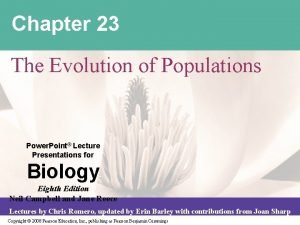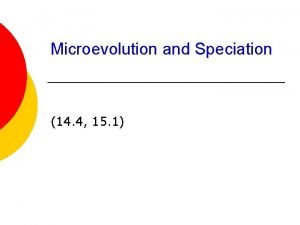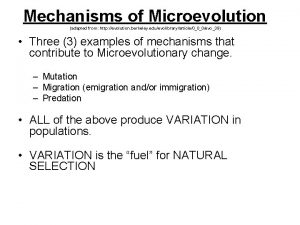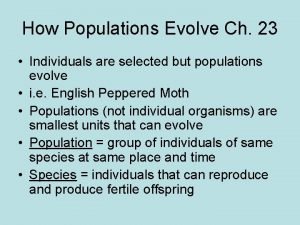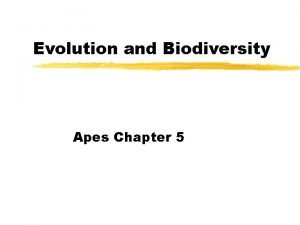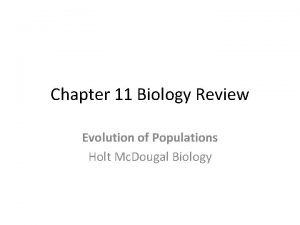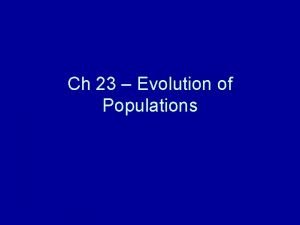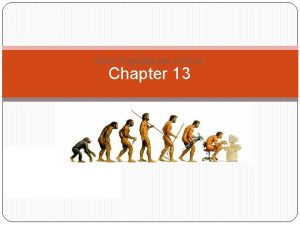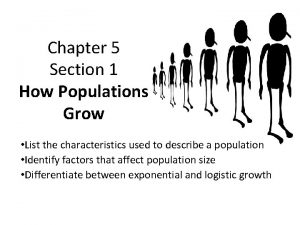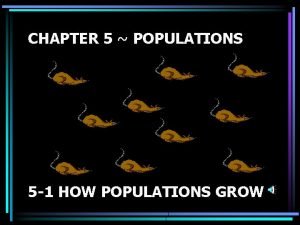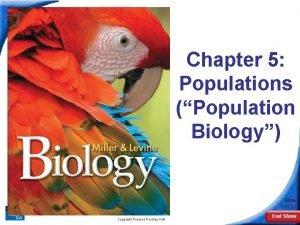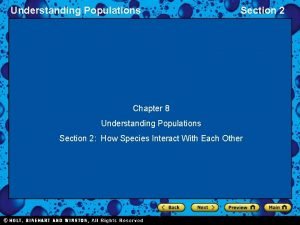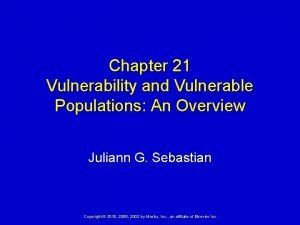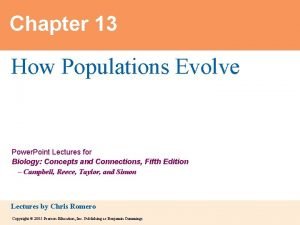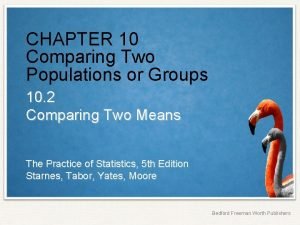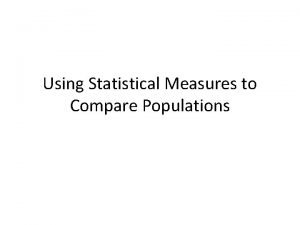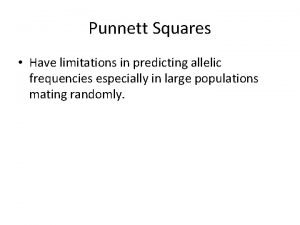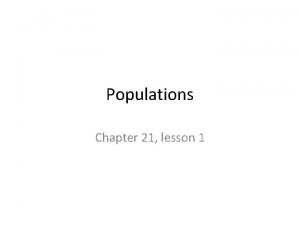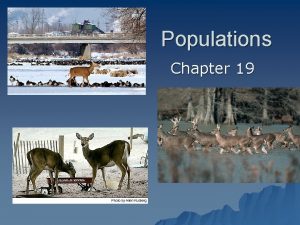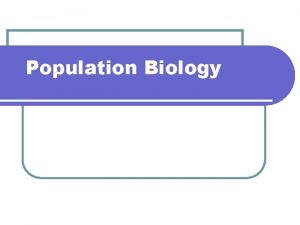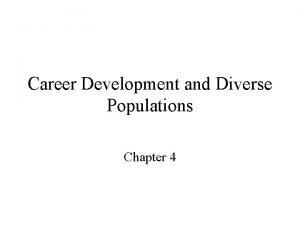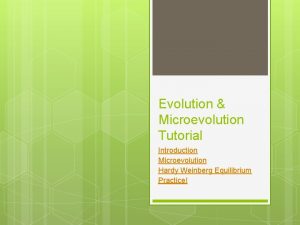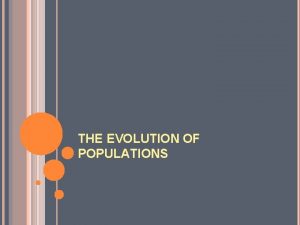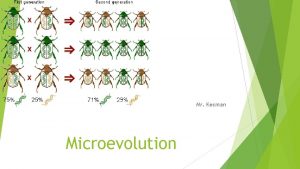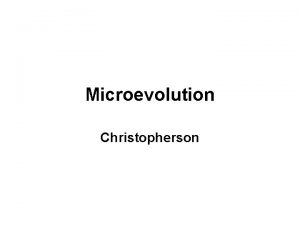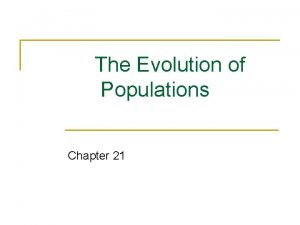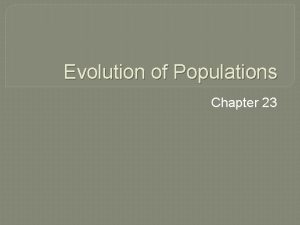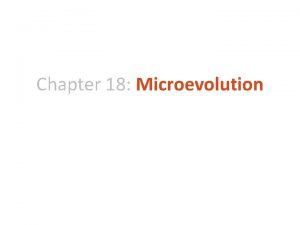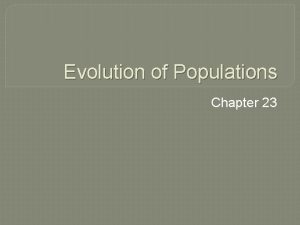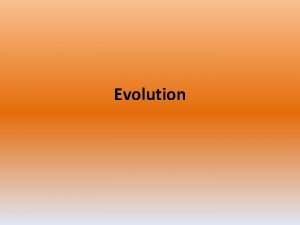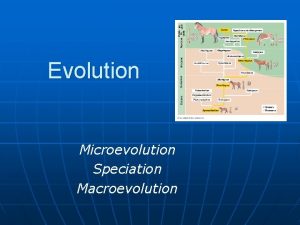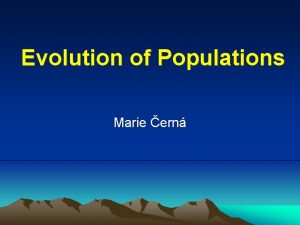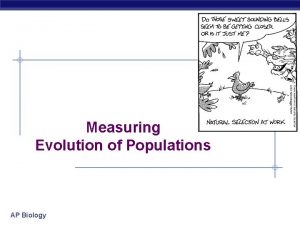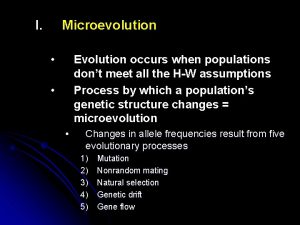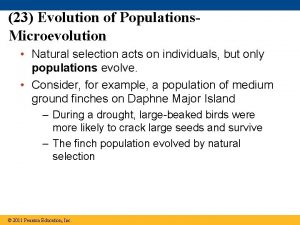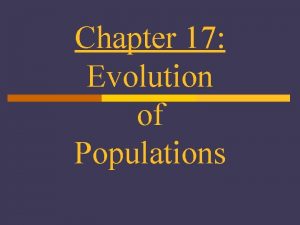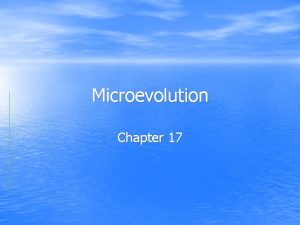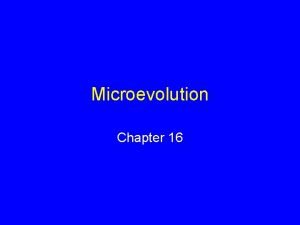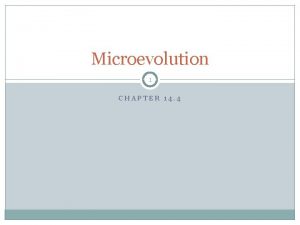EVOLUTION OF POPULATIONS Chapter 21 Microevolution EVOLUTION ON


































- Slides: 34

EVOLUTION OF POPULATIONS Chapter 21

Microevolution EVOLUTION ON THE SMALLEST SCALE =A CHANGE IN GENE FREQUENCY

GENETIC VARIATION WHAT CAUSES VARIATION? MUTATIONS! SEX! Environment?

Figure 21. 5 a (a) Caterpillars raised on a diet of oak flowers © 2014 Pearson Education, Inc.

Figure 21. 5 b (b) Caterpillars raised on a diet of oak leaves © 2014 Pearson Education, Inc.

GENETIC VARIATION HOW DO WE MEASURE GENETIC VARIATION?

GENETIC VARIATION WHAT CAUSES VARIATION? MUTATIONS! - NEW ALLELLES SEX! - NEW COMBINATION OF ALLELES

MUTATIONS Point mutations Exons Introns Wobble Hypothesis Duplications Olfactory genes - see Shubin Translocations

SEX No new alleles, just new combinations by Crossing over Independant Assortment Fertilization

INDEPENDAN CROSSING T ASSORTMEN OVER T


21. 3 NATURAL SELECTION, GENETIC DRIFT, AND GENE FLOW ALTER ALLELE FREQUENCIES IN A POPULATIONS

NATURAL SELECTION allele frequency change to make population a better fit for environment —> Adaptive Evolution Beak of the Finch

GENETIC DRIFT Chance events alter genetic frequency from one generation to the next This fluctuation due to chance, not necessarily leaving more fit individuals for environment to survive and reproduce 2 situations that result in genetic drift are the bottleneck effect and founder effect

FOUNDER EFFECT OLD ORDER AMISH OF PA

Figure 21. 10 Original Surviving Bottlenecking population event (a) By chance, blue marbles are overrepresented in the surviving population. (b) Florida panther (Puma concolor coryi) © 2014 Pearson Education, Inc.

Figure 21. 10 a-1 Original population (a) By chance, blue marbles are overrepresented in the surviving population. © 2014 Pearson Education, Inc.

Figure 21. 10 a-2 Original population Bottlenecking event (a) By chance, blue marbles are overrepresented in the surviving population. © 2014 Pearson Education, Inc.

Figure 21. 10 a-3 Original population Bottlenecking event Surviving population (a) By chance, blue marbles are overrepresented in the surviving population. © 2014 Pearson Education, Inc.

(b) Florida panther (Puma concolor coryi) vhttp: //www. floridapanthernet. org/index. php/h andbook/history/florida_panther_genetics/#. V d. U 2 Em. DB 4 UU © 2014 Pearson Education, Inc.

Figure 21. 11 Pre-bottleneck (Illinois, 1820) Post-bottleneck (Illinois, 1993) Greater prairie chicken Range of greater prairie chicken (a) Population size Number of alleles per locus 1, 000– 25, 000 5. 2 93 <50 3. 7 <50 Kansas, 1998 (no bottleneck) 750, 000 5. 8 99 Nebraska, 1998 (no bottleneck) 75, 000– 200, 000 5. 8 96 Location Illinois 1930– 1960 s 1993 (b) © 2014 Pearson Education, Inc. Percentage of eggs hatched

Figure 21. 11 a Pre-bottleneck Post-bottleneck (Illinois, 1820) (Illinois, 1993) Greater prairie chicken (a) © 2014 Pearson Education, Inc. Range of greater prairie chicken

Figure 21. 11 b Population size Number of alleles per locus Percentage of eggs hatched 1, 000– 25, 000 <50 5. 2 3. 7 93 <50 Kansas, 1998 (no bottleneck) 750, 000 5. 8 99 Nebraska, 1998 (no bottleneck) 75, 000– 200, 000 5. 8 96 Location Illinois 1930– 1960 s 1993 (b) © 2014 Pearson Education, Inc.

Figure 21. 11 c Greater prairie chicken © 2014 Pearson Education, Inc.

▪ Researchers used DNA from museum specimens to compare genetic variation in the population before and after the bottleneck ▪ The results showed a loss of alleles at several loci ▪ Researchers introduced greater prairie chickens from populations in other states and were successful in introducing new alleles and increasing the egg hatch rate to 90% © 2014 Pearson Education, Inc.

Effects of Genetic Drift: A Summary 1. Genetic drift is significant in small populations 2. Genetic drift can cause allele frequencies to change at random 3. Genetic drift can lead to a loss of genetic variation within populations 4. Genetic drift can cause harmful alleles to become fixed © 2014 Pearson Education, Inc.

GENE FLOW Transfer of alleles into or out of a population

Figure 21. 12 Central population NORTH SEA Eastern population Vlieland, the Netherlands 2 km 60 50 Population in which the surviving females eventually bred Parus major Central Survival rate (%) Eastern 40 30 20 10 0 © 2014 Pearson Education, Inc. Females born in central population Females born in eastern population

Figure 21. 12 a 60 Survival rate (%) 50 Population in which the surviving females eventually bred Central Eastern 40 30 20 10 0 © 2014 Pearson Education, Inc. Females born in central population Females born in eastern population

21. 4 Natural Selection is only mechanism of evolution that leads to inreased relative fitness




 Chapter 16 evolution of populations vocabulary review
Chapter 16 evolution of populations vocabulary review Chapter 17 evolution of populations answer key
Chapter 17 evolution of populations answer key Chapter 23 the evolution of populations
Chapter 23 the evolution of populations Section 16-1 genes and variation
Section 16-1 genes and variation Chapter 23 the evolution of populations
Chapter 23 the evolution of populations Genetic drift vs gene flow vs natural selection
Genetic drift vs gene flow vs natural selection 3 mechanisms of microevolution
3 mechanisms of microevolution Agents of microevolution
Agents of microevolution Microevolution
Microevolution Microevolution
Microevolution P2 2pq q2
P2 2pq q2 Evolution of populations section 16-1 genes and variation
Evolution of populations section 16-1 genes and variation Evolution of populations section 16-1 genes and variation
Evolution of populations section 16-1 genes and variation Evolution of populations section 11 review
Evolution of populations section 11 review Smallest unit of evolution
Smallest unit of evolution Chapter 13 how populations evolve test
Chapter 13 how populations evolve test Chapter 5 lesson 1 how populations grow answer key
Chapter 5 lesson 1 how populations grow answer key Chapter 5 lesson 1 how populations grow
Chapter 5 lesson 1 how populations grow Chapter 10 comparing two populations or groups crossword
Chapter 10 comparing two populations or groups crossword Chapter 5 lesson 1 how populations grow
Chapter 5 lesson 1 how populations grow Chapter 8 understanding populations
Chapter 8 understanding populations Chapter 21 vulnerability and vulnerable populations
Chapter 21 vulnerability and vulnerable populations Chapter 13 how populations evolve
Chapter 13 how populations evolve Chapter 10 comparing two populations or groups
Chapter 10 comparing two populations or groups Using statistical measures to compare populations
Using statistical measures to compare populations Territoires populations et développement quels défis
Territoires populations et développement quels défis A biologist discovers two populations of wolf spiders
A biologist discovers two populations of wolf spiders What are the limitations of punnett squares
What are the limitations of punnett squares Lesson 1 populations answer key
Lesson 1 populations answer key Section 19-1 review understanding populations answer key
Section 19-1 review understanding populations answer key Gene pool
Gene pool Populations biology definition
Populations biology definition Population growth concept map answers
Population growth concept map answers Kar 5
Kar 5 Gage definition
Gage definition




